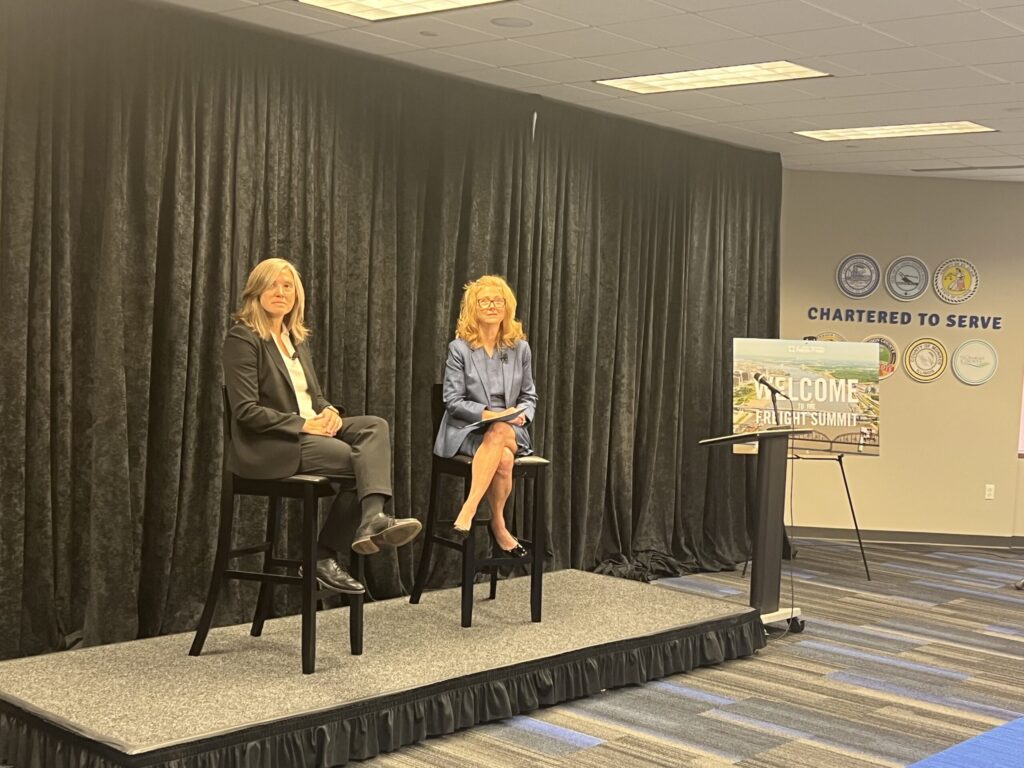Freight Summit featured keynote by IDOT’s Gia Biagi and updates from MoDOT’s Ed Hassinger, both focused on historic investments and shared priorities supported by a culture of collaboration
The headline event of FreightWeekSTL 2025, brought together transportation leaders and industry stakeholders to spotlight the transformative infrastructure investments underway in Illinois and Missouri and to underscore the St. Louis region’s growing role in national freight movement. Hosted by the St. Louis Regional Freightway, the June 4 Freight Summit featured a keynote address by recently confirmed Illinois Department of Transportation (IDOT) Secretary Gia Biagi, who emphasized the importance of infrastructure investment, cross-border collaboration and community-centered planning in advancing freight mobility. A video address by Missouri Department of Transportation (MoDOT) Director Ed Hassinger rounded out the program and reinforced that collaboration remains key to leveraging the bi-state St. Louis region’s unique advantages.
Biagi, who was named as IDOT Secretary in December 2024, drew on her extensive background in urban planning and transportation to outline the vision for Illinois’ $40 billion multi-year program – part of the biggest capital plan in the history of the State of Illinois. “We see our investments in transportation as a fundamental of economic development,” said Biagi.
She highlighted the state’s unique multimodal advantages, including its position as a hub for all Class I railroads and its strategic location connecting the Great Lakes to the Mississippi River and on to the Gulf of America. Biagi also underscored the importance of aligning infrastructure investments with economic development strategies and community needs, noting that a recent $400 million funding opportunity drew $5 billion in project requests from across Illinois. While that might be alarming to some, Biagi said she thinks it’s great, because she now has the next needs list.
Her keynote also celebrated the longstanding collaboration between IDOT and the Missouri Department of Transportation (MoDOT), citing joint efforts such as the Interstate 270 (I-270) improvement project that includes the Chain of Rocks Bridge connecting both states across the Mississippi River.
“There’s a saying that the speed of trust is slow, and we have built trust across our organizations slowly, over many, many decades really, collaborating and finding wins together,” Biagi said. “Think about that. Two states doing a well-timed mutual procurement for the same project to make sure there’s alignment when we get to the other side and we need to make an award, and it’s the same contractor. I don’t know a lot of states that could pull that off. I see here a great template for how we could do things all across our borders.”
She acknowledged that there is going to be tension about some things when such large projects are involved. “We’re going to try to figure out the funding strategy … figure out who leads and who follows … and if you’re doing this on one side or the other. But the trust that’s built on relationships over all of these years – and that includes so many of you here – that is what make it possible for us to do great things,” said Biagi.
She also called attention to the St. Louis Regional Freightway’s role as a convener, highlighting its Freight Development Committee that both IDOT and MoDOT participate in, along with representative of East-West Gateway Council of Governments, all modes of transportation, the manufacturing and logistics industries and academia.
“The Freightway has really been leading the way,” Biagi said. “We share that core value around collaboration and making sure that everybody is not just at the table but has a say at that table, that you have some power at that table that you can move the discussion.”
MoDOT Director Ed Hassinger echoed many of Biagi’s sentiments in his remarks, delivered via a pre-recorded video address. He highlighted Missouri’s record $13.2 billion five-year plan, made possible by increased federal and state funding, including general revenue dedicated to transportation for the first time in state history.
“We have been entrusted with more money than we’ve had in a really long time,” said Hassinger. “That’s going to allow us to take care of some huge priorities that we’ve been talking about for years. And MoDOT has a track record of delivering.”
He shared that MoDOT has delivered over 4,000 projects under budget and on time over the past decade, and how he wants that track record to continue as they tackle long-standing priorities. He highlighted the completed rebuild of I-270 in North St. Louis County — the largest project in MoDOT’s history at the time — and the newly awarded Interstate 70 (I-70) upgrade from Wentzville to Warrenton, now the largest project ever awarded by the agency. Hassinger emphasized the importance of leveraging Missouri’s geographic advantages, including its central location, two major rivers, six Class I railroads, and relatively uncongested interstates.
“We have to collaborate and make sure all of those industry partners and public sector partners work together to get the most benefit out of this advantage that we have in this region and in the state of Missouri,” Hassinger said. “Collaboration is a key component, and I know that’s what everybody here at the conference is doing.”
Mary Lamie, Executive Vice President of Multimodal Enterprises at Bi-State Development and head of the St. Louis Regional Freightway, moderated the keynote. She expressed appreciation for the collaboration between the two transportation agencies and their willingness to work across state lines.
“We appreciate today’s comments because we know the businesses in this area also don’t recognize the state line or the Mississippi River as a barrier.” Lamie said. “We have Bunge, Boeing, World Wide Technology, Terminal Railroad Association and others. They’re doing work on both sides of the river. They just look at this as an entire logistics system. We all appreciate learning about the commitments to statewide infrastructure improvements, including projects that will keep freight moving through southwestern Illinois, throughout the Bi-State region and throughout the nation.”

